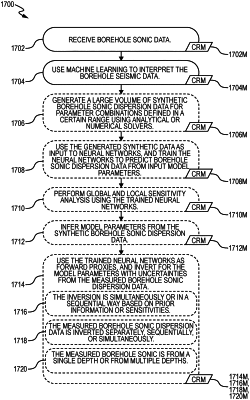| CPC G01V 1/50 (2013.01) [G01V 1/46 (2013.01); G06N 3/08 (2013.01); G01V 2210/20 (2013.01); G01V 2210/626 (2013.01)] | 5 Claims |

|
1. A method for processing borehole sonic dispersion data, comprising:
defining a frequency range;
defining a slowness range;
receiving the borehole sonic dispersion data;
categorizing the borehole sonic dispersion data into a plurality of discrete slowness-frequency points based at least in part on the defined frequency and slowness ranges;
classifying the plurality of discrete slowness-frequency points into a plurality of cluster classes;
identifying each respective cluster class in the plurality of cluster classes that exhibit large misfit residual error and removing the respective cluster class;
combining the plurality of discrete slowness-frequency points in the remaining cluster classes into a combined dataset;
inverting the combined dataset to generate a dipole dispersion curve and a refined dataset;
until a stop criterion is met, iteratively:
applying an adaptive filter to the refined dataset to identify and remove points in the refined dataset that are outliers from the dipole dispersion curve; and
inverting the refined dataset; and
filtering the refined dataset based at least in part on a predefined distance from the dipole dispersion curve.
|